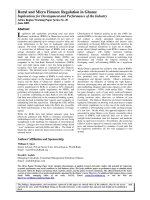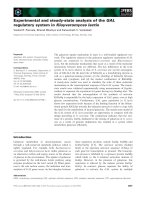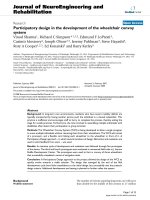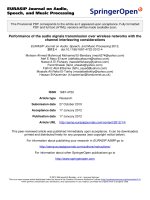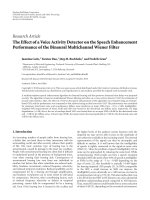Performance of the agricultural extension personnel in the revitalized extension system in manipur, India
Bạn đang xem bản rút gọn của tài liệu. Xem và tải ngay bản đầy đủ của tài liệu tại đây (169.54 KB, 5 trang )
Int.J.Curr.Microbiol.App.Sci (2018) 7(7): 2085-2089
International Journal of Current Microbiology and Applied Sciences
ISSN: 2319-7706 Volume 7 Number 07 (2018)
Journal homepage:
Original Research Article
/>
Performance of the Agricultural Extension Personnel in the Revitalized
Extension System in Manipur, India
R. Akoijam*, M.K. Singh, Daya Ram, M. Deepa Devi and Ch. Narendrajit Singh
College of Agriculture, Central Agricultural University Imphal-795004, Manipur (India)
*Corresponding author
ABSTRACT
Keywords
Level of role
performance;
Agriculture
Technology and
Management
Agency and
Extension reform.
Article Info
Accepted:
15 June 2018
Available Online:
10 July 2018
The present study was carried out in the 4 Districts of Manipur to access the level of role
performance as perceived by the agricultural extension personnel (Assistant technology
manager) in the revitalized extension system in Manipur. A purposive sampling technique
was followed and statistical methods such as frequency, percentage, standard deviation,
Pearson product moment coefficient of correlation and multiple regression analysis were
used for analysing the data. Data were collected through personal interview method during
the period of January 2018 to march 2018. A total of 54 respondents were interviewed
with the help of the structured schedule. A total of 12 independent variables were selected
for the study which was categorized into three categories, namely „Personal variables‟,'
Psychological variables‟ and „Organizational variables'. The study implies that the level of
role performance of the respondents had positive and significant correlation with training
exposure, decision making ability, role awareness, role perception, and attitude towards
ATMA, motivational climate, job satisfaction and achievement motivation. The value of
coefficient of multiple determination (R2) being 0.780 indicated that the positively
correlated significant variables jointly could predict 78 per cent of the variation in level of
role performance of the extension personnel.
Introduction
In country like India where Agro-climatic
zones widely differ besides significant
variation in socioeconomic status of farmers‟,
uniform extension service is not the panacea
for all the regions. It has been realized that the
public sector extension system on its own is
not capable enough to meet the ever
increasing and multifaceted demands of the
farming community due to several constraints
or weaknesses in the system. It was realized
that public extension system will have to be
placed in new decentralized institutional
arrangements which are demand driven,
farmer-accountable, bottom up and have
farming system approach. To address the
situation, the Government of India (GOI) and
the World Bank pilot-tested a new,
decentralized, market-driven extension model
under the National Agricultural Technology
Project (NATP). The Key institution in
implementing this new approach was the
Agricultural Technology Management Agency
2085
Int.J.Curr.Microbiol.App.Sci (2018) 7(7): 2085-2089
(ATMA) which was responsible for
facilitating and coordinating “farmer-led”
extension activities within each district. The
Agricultural Technology Management Agency
(ATMA) calls for integrated approach wherein
different stakeholders come closer to plan,
organise, and execute the activities to take full
advantage of the technologies demonstrated in
the operational area. In the midst of this
change, extension system is grappling with the
question of how best to harness „extension
reform‟ to improve farming community. The
effective implementation of „ATMA‟ largely
depends on how effectively the extension
functionaries perceive their roles and perform
those. There have been very few studies
related to performance appraisal of the
extension functionaries working under this
changing scenario. Performance deals with the
outcomes, results and accomplishments
achieved by a person, group or organization”.
The role performance in the study has been
operationally defined as the accomplishment,
execution, carrying out, working out of
anything ordered or undertaken, the doing of
any action or work to (Oxford English
Dictionary, 2001). Hence, the present study
was contemplated to measure the level of role
performed as perceived by the agricultural
extension personnel (Assistant Technology
Manager) in the revitalized extension system
in Manipur.
were 16 Districts in Manipur State. Out of
these, 4(four) Districts were purposively
selected for the present study because it is in
valley area of Manipur and Agricultural
Technology Management Agency (ATMA)
was also constituted in these Districts under
Central Government fully funded by Central
Government in all the Districts of Manipur
State. A total of 54 ATM (Assistant
Technology Manager) were selected and
interviewed in the 4 selected Districts in the
study. The primary data in the present study
were collected directly from the respondents
with the help of the structured schedule
through personal interview method. The data
analysis was done by using various statistical
methods which were frequency, percentage,
standard deviation, Pearson product moment
coefficient of correlation and multiple
regression analysis.
Results and Discussion
Performance of the agricultural extension
personnel in the revitalized extension
system
It was found that majority of the respondents
(61.11%) had medium level of role
performance followed by 22.22 per cent
respondents who had high level of role
performance. The rest 16.67 per cent had low
level of role performance.
Materials and Methods
The present study was conducted in Manipur,
one of the states of North eastern India, lying
between 23 50´ North to 25 42´ North
latitudes and 92 58´ east to 94 45´ East to
East longitudes. The state has an area of
22,327sq.km, which accounts for about 0.68%
of the country's total geographical area.
Manipur has a total population of 28, 55,794
(as per 2011 census) which account for about
0.023 percent of the country`s total
population. At the time of the study, there
The study revealed (Table-2) that the level of
role performance of the respondents had
positive and significant correlation with
training exposure (r=0.93**),decision making
ability (r=0.71**) role awareness (r=0.91**),
role perception (r=0.93**), attitude towards
ATMA (r=0.92**), achievement motivation
(r=0.653**), motivational climate (r=0.93**),
job satisfaction (r=0.92**) and achievement
motivation(r=0.91**). It can be seen that
variables like training exposure, role
awareness, role perception, attitude towards
ATMA, motivational climate, job satisfaction,
2086
Int.J.Curr.Microbiol.App.Sci (2018) 7(7): 2085-2089
and achievement motivation had strong
relationship with the role performance of the
extension personnel, the variables decision
making ability showed moderately strong
relationship with the role performance of the
extension personnel. The variables „training
exposure‟ showed significant relationship with
the level of performance of extension
personnel. The reason might be the fact that
higher exposure to training developed better
insight through increased information and
participation with different sources of
information. The people who had high degree
of „training exposure‟ were more likely to
have social mobility, more expose to outside
contact and had a tendency to change over to
new ideas and culture rather than remaining
conservative and tradition oriented. They
might consider ATMA as an enterprise and
therefore, might have better contacts with
information generating sources as well as
extension agencies to seek specific knowledge
under extension reform (Awasthi et al., 2001;
Yadav et al., 2010; Das et al., 2010 and Maiti
et al., 2011).
Positive relationship with „Attitude towards
ATMA‟ suggests that most of the extension
functionaries were more aware about the
importance of ATMA which
ultimately
influenced high and whole hearted
participation in performance. The positive
relationship with „Role awareness‟ and „Role
perception‟ suggest that they were more
conscious about their role and their duties
which ultimately influence the performance
level. Increased awareness and perception of
their role increases their involvement in their
role which has reflected through the positive
relationship with role performance. The
variable „Achievement motivation‟ showed
significant relationship with the level of
performance of extension personnel. This
might be because of the fact that the
respondents spontaneously expressed desire to
do something well for its own sake which is
ultimately reflected through their increased
level of performance (Reddy and Jayaramaiah,
1990; Manjunath and Shashidahra, 2011).
The organizational variables like „Motivational
climate‟ and „Job satisfaction‟ were positively
correlated with the level of role performance.
The degree of happiness with one‟s job and
working environment is related with the
performance level. It suggests that the
prevailing environment in the organization
activates, energizes, and directs the employee
towards the achievement of organizational and
personal goals. Positive relationship was found
between „Job satisfaction‟ and „Performance‟.
It might be because of the fact that with the fair
amount of job satisfaction‟s component like job
security, recognition and fair evaluation, human
relation at work, future prospects, capacity and
confidence to shoulder job responsibilities
increases the performance level of the
employee of an institution (Judge and Hulin,
1993; Judge et al., 2001; Adeyemi, 2008;
Moyes et al., 2008 and Manjunath and
Shashidahra 2011). And no relation is found
between age, education qualification, service
experience, and job anxiety with the level of
role performance.
Table-3 reveals that all the 12 variables were
taken for multiple regression analysis. Out of
12 variable 3 variables namely, role awareness,
role perception and motivational climate
contribute significantly to the prediction of the
level of role performance. The three
characteristics may be termed as good predictor
of level of role performance of the pooled
sample. It was observed that motivational
climate assumed the most important
characteristics (b=0.312) changing the level of
role performance of the agricultural extension
personnel followed by role perception
(b=0.191) and role awareness with significant
characteristics
(b=0.157).
The
12
characteristics
jointly
could
explained
(R²=0.780) 78 per cent of variation in the level
of role performance of the agricultural
extension personnel.
2087
Int.J.Curr.Microbiol.App.Sci (2018) 7(7): 2085-2089
Table.1 Distribution of respondents according to their level of role performance
Sl.No. Level of
Score
Category
range
1.
Low level of role
120
performance
to149
2.
Medium level of
150
role performance
to181
3.
High level of role
182
performance
to210
Frequency
Percentage
9
16.67
Mean
SD
165.45
33
61.11
12
22.22
16.23
N=54
CV
9.81
Table.2 Relationship between the independent variables and with the role performance
Sl.No.
X1
X2
X3
X4
X5
X6
X7
X8
X9
X10
X11
X12
Correlation coefficient „r‟ value
0.152
-0.100
0.365
0.927**
0.711**
0.905**
0.925**
0.914**
0.930**
0.922**
-0.080
0.912**
Independent variables
Age
Education qualification
Service experience
Training exposure
Decision making ability
Role awareness
Role perception
Attitude towards ATMA
Motivational climate
Job satisfaction
Job anxiety
Achievement motivation
** Significant at 0.01 level of probability
Table.3 Contributory effects of selected independent variables on the role performance
Sl.No.
X1
X2
X3
X4
X5
X6
X7
X8
X9
X10
X11
X12
Independent variables
Age
Education qualification
Service experience
Training exposure
Decision making ability
Role awareness
Role perception
Attitude towards ATMA
Motivational climate
Job satisfaction
Job anxiety
Achievement motivation
* Significant at 0.05 level of probability
F = 48
R2 = 0.780
„t‟ value
b value
0.023
-0.019
0.012
0.139
0.022
0.157*
0.191*
0.108
0.312*
0.054
-0.010
0.071
adjusted R2 = 0.771
2088
1.02
-0.78
0.40
1.75
0.57
2.65
3.28
1.46
4.72
0.84
-0.39
1.13
Int.J.Curr.Microbiol.App.Sci (2018) 7(7): 2085-2089
The significant F-value at 0.05 level of
probability (F=48) indicated the significant
effectiveness of the 12 characteristics in
determining the level of role performance of the
agricultural extension personnel (assistant
technology manager) when worked jointly.
Higher level of role performance is likely to
impact positively on employees‟ and
organization‟s well-being. A highly significant
and positive correlation of independent
variables with the level of role performance
indicated that the extension personnel with
higher training exposures, higher decision
making ability, higher role awareness, higher
role perception, highly favourable attitude
towards ATMA, more favourable motivational
climate and higher job satisfaction and higher
achievement motivation were likely to influence
the level of role performance to great extent.
Where these attributes are at lower level in the
extension personnel, suitable management
strategies may be adopted to modify their
behaviour for increased level of performance of
their roles.
Acknowledgement
The authors acknowledge the contributions of
R. Akoijam, M.K.Singh, Daya Ram, M.Deepa
Devi and Ch. Narendrajit Singh, College Of
Agriculture, Central Agricultural University,
Imphal, Manipur (India) for their technical
support and valuable contributions to the
manuscript
References
Awasthi, H.K., Singh, P.R. and Sharma, R.N.
(2001). Job performance of anganwadi
workers. Indian Res. J. Ext. Edu., 1 (2): 99101.
How to cite this article:
Maiti, S., Jha, S.K. and Garai, S. (2011).
Performance of public-private-partnership
model of veterinary services in West
Bengal. Indian Res. J. Ext. Edu., 11 (2):
43-46.
Das, A., Basu, D. and Goswami, R. (2010).
Factors influencing retailing performance
of farm inputs in South 24 Parganas
District of West Bengal. Indian Res. J. Ext.
Edu., 10 (3): 49-52.
Yadav, V.P.S., Verma, H.K., Dalal, R.S., Yadav,
S.K. and Yadav, B. (2010). Correlates of
farmers‟ variables with productivity in
dryland Crops. Indian Res. J. Ext. Edu.,
10(1): 16-19.
Reddy, R.T. and Jayaramaiah, K.M. (1990).
Relationship of selected variables on the
productivity of village extension officers.
Indian J. Ext. Edu., XXVI (1&2) : 78-81.
Manjunath, L. and Shashidahra, K.K. (2011).
Determinates of scientific productivity of
agricultural scientists. Indian Res. J. Ext.
Edu., 11 (1): 7-12.
Judge, T.A., Thoresen, C.J., Bono, J.E. and
Patton, G.K. (2001). The job satisfactionjob performance relationship: A qualitative
and quantitative review. Psychol. Bull.,
127: 376-407.
Moyes, G.D., Shao, L.P. and Newsome, M.
(2008). Comparative analysis of employee
job satisfaction in the accounting
profession. J. Busin. Eco. Res., 6(2): 65-81.
Judge, T.A. and Hulin, C.L. (1993). Job
satisfaction as a reflection of a disposition:
a multiple source causal analysis. Orgn.
Behav. Hum. Dec. Proc., 56: 388-421.
Adeyemi, T.O. (2008). Organisational climate
and teachers‟ job performance in primary
schools in Ondo State, Nigeria: An
Analytical Survey. Asian J. Inform. Tech.,
7(4): 138-145.
Oxford English Dictionary (2001). Oxford
University Press Inc., New York
Akoijam, R., M.K. Singh, Daya Ram, M. Deepa Devi and Narendrajit Singh, Ch. 2018. Performance of
the Agricultural Extension Personnel in the Revitalized Extension System in Manipur, India.
Int.J.Curr.Microbiol.App.Sci. 7(07): 2085-2089. doi: />
2089
